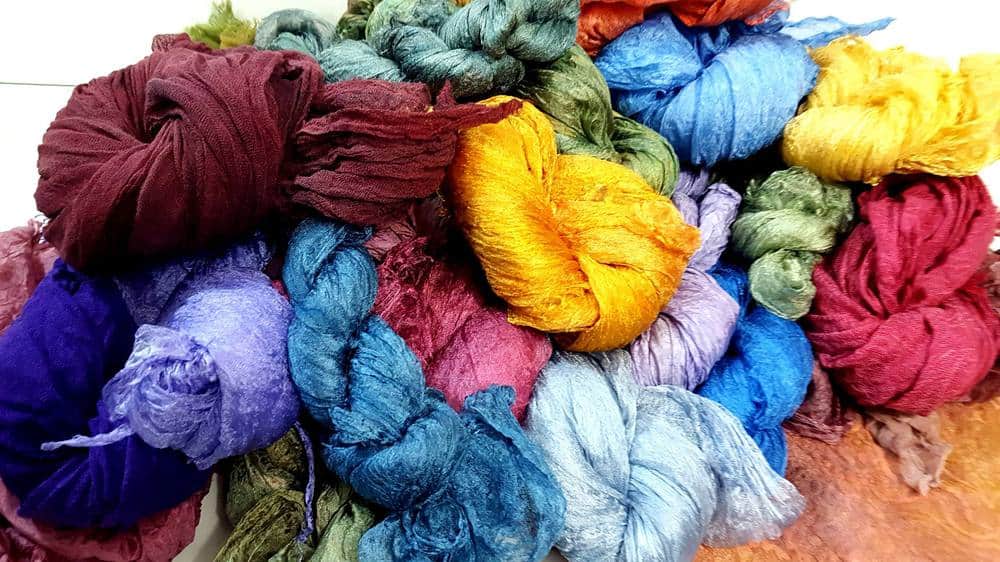Silk Fabric for Nuno Felting
What’s the first thing that comes to mind when you hear - Nuno Felting? But, of course, natural silk! It’s light, airy and elegant, drapes beautifully, can be easily shaped into any texture, bonds well with wool and is pleasant to the touch.
What is silk fabric?


Silk is an entirely natural material; often referred to as the Queen of Fabrics. It dates back to ancient China and utilized widely in Europe and Asia. Silk is produced from a silkworm that’s fed Mulberry leaves and spins a cocoon while it matures. Mulberry Silk is the highest quality silk available for purchase and is the result of silkworms’s cocoons who are reared in captivity.
Properties of Natural Silk Fabrics
Natural silk is more expensive than its synthetic counterparts, but very well worth the extra money:
-
Pleasantly soft and smooth to the touch;
-
Warms quickly to the temperature of your body;
-
Excellent at absorbing water;
-
Any small crumples and folds are naturally ironed out, as you are wearing the item;
-
If you cut the cloth, the yarns don’t fall from the edge, which is often a problem with synthetics;
-
Beautiful pearl gleam that changes hues depending on the lighting.
How Can You Verify That Your Silk is 💯 Natural?
The easiest and surest method is to pull a few yarns from the fabric and set them on fire. Unlike synthetics, natural silk will:
- Burn slowly rather than melt;
- Give off a smell similar to that of burnt wool or feathers, rather than of heated plastic. Viscose, that’s natural silk substitute of vegetable origin, will smell like burnt paper.
- The ashes of natural silk are easily scattered, while the remains of synthetics turn into a hard lump and you can rub viscose ashes between you fingers.
What Does MM Stand For?
The misleading abbreviation has nothing to do with millimeters. Momme (sounds like mummy) is a traditional unit characterising the quality of silk fabric in terms of density. One momme means that a piece of fabric that’s 100 yards long and 45 inches wide weighs 1 pound (which equals to 4.34 grams per square meter). Eight mm means that a similar sized piece weighs 8 pounds (this is about 1 ounce per square yard or about 35 grams per square meter).
Below are examples of momme fabric measurements most commonly used for nuno felting:
|
Fabric
|
MM
|
|
Margilan silk gauze
|
Around 2.5
|
|
Gauze
|
3 to 5
|
|
Organza
|
4 to 6
|
|
Habotai
|
5 to 18
|
|
Chiffon
|
3.5 to 8
|
For light nuno felt projects, choose silk that’s about 3-6 mm.
Best Materials For Nuno Felting Projects
If you take a dense and thick piece of cloth that would be perfect for sewing, the project will be a disaster. Unless the fabric is loose enough for wool fibers to penetrate through the holes, the wool will just fall apart, and you’ll have a separate piece of felt and a separate piece of silk, instead of one article! But if you have a thin, loose fabric and you can clearly see the holes between the yarns when placed against a source of light, the fabric is perfect and all you need now is practice. Remember, the larger the holes, the easier the process.
Margilan Silk Gauze
For light, airy articles use thinned (rarefied) silk. Once you start felting, it bonds with wool in no time. A great option is Margilan silk gauze. The material is extremely light – just around 2.5 mm. It owes its name to the city of Margilan, Uzbekistan, where it is manufactured. The fabric is widely used by feltmakers and is rapidly gaining popularity across the world.
Silk Gauze
One of the best materials for Nuno Felting is Silk Gauze. It is similar to Chiffon but an even lighter weight (3-5 mm). An extremely sheer and delicate fibre with a very soft hand and floaty drape. Dyes and paints easily with great colour retention. It is produced by method of a special gauze interweave with two weft yarns interwoven before and after each warp yarn.
Organza
Its name is derived from the word “Urgang,” which is a name of a town in Turkestan region that was home to one of the most popular silk markets of ancient world. Organza (4 to 6 mm) is a thin, plain weave, sheer fabric traditionally made from silk. Its delicate and gauzy, but feels hard and dense. Wrinkles easily and creates more volume than Chiffon, for instance. Nuno felt made with Organze is quite rough. Since this type of material is great at keeping shape, its the best choice for cuffs and collars.
Habotai
Habotai or Habutai (also known as toile) is one of the most basic plain weaves of silk fabric. Traditionally, used for Japanese garments, such as kimonos. Soft and smooth, it might seem dense compared with gauze (5 to 18), but its lighter versions are quite a good option for nuno felting.
Chiffon
Chiffon is a crepe-like material produced by plain weave from twisted yarns. It is a bit denser than gauze (3.5 to 8 mm). This fabric has a very fine weave, is translucent, lightweight and smooth. Crushed Chiffon is great for creating beautiful textures.
For best silk fabric selection, visit our store! Have fun and be creative!


